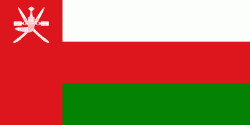Flag of Oman
The national flag of Oman (علم عُمان) consists of three stripes (white, green and red) with a red bar on the left that contains the national emblem of Oman (Dagger and two swords).
Until 1975, Oman used the plain red banner of the indigenous people. In 1970, the Sultan introduced a complete new set of national flags. Bands of green and white were added to the fly, and the national emblem, the badge of the Albusaidi Dynasty, was placed in the canton. This depicts crossed swords over a khanjar, a traditional curved dagger. White has been associated historically with the Imam, the religious leader of Oman, and at times the political rival to the ruling Sultan. It also symbolizes peace. Green is traditionally associated with the Jabal al-Akdar, or "Green Mountains," which lie toward the north of the country. Red is a common color in Gulf state flags. The national emblem is said to date back to the 18th century. A curved dagger is fastened over a pair of crossed swords. An ornate horsebit links the weapons.
Between 1970 and 1995, the size of the middle band of the triband was slimmer than the other two, making up approximately one fifth of its height, the other bands two-fifths.
The naval ensign shows an azure (blue) field, with the Oman in the canton or top-left quarter and the naval service emblem in the fly.
The standard of the Sultan of Oman is red with a green border whose width is about one-sixth of the height of the flag, surrounded by a red border of about the same width. It bears the country's emblem as a charge in the center, colored gold.
Until 1975, Oman used the plain red banner of the indigenous people. In 1970, the Sultan introduced a complete new set of national flags. Bands of green and white were added to the fly, and the national emblem, the badge of the Albusaidi Dynasty, was placed in the canton. This depicts crossed swords over a khanjar, a traditional curved dagger. White has been associated historically with the Imam, the religious leader of Oman, and at times the political rival to the ruling Sultan. It also symbolizes peace. Green is traditionally associated with the Jabal al-Akdar, or "Green Mountains," which lie toward the north of the country. Red is a common color in Gulf state flags. The national emblem is said to date back to the 18th century. A curved dagger is fastened over a pair of crossed swords. An ornate horsebit links the weapons.
Between 1970 and 1995, the size of the middle band of the triband was slimmer than the other two, making up approximately one fifth of its height, the other bands two-fifths.
The naval ensign shows an azure (blue) field, with the Oman in the canton or top-left quarter and the naval service emblem in the fly.
The standard of the Sultan of Oman is red with a green border whose width is about one-sixth of the height of the flag, surrounded by a red border of about the same width. It bears the country's emblem as a charge in the center, colored gold.
National flag
Country - Oman
Warning: getimagesize(/Image/Map/MP286963.gif): failed to open stream: No such file or directory in /home/mapnlee7/public_html/MAPNALL/article.php on line 532
 |
 |
From the 17th century, the Omani Sultanate was an empire, vying with the Portuguese and British empires for influence in the Persian Gulf and Indian Ocean. At its peak in the 19th century, Omani influence and control extended across the Strait of Hormuz to Iran and Pakistan, and as far south as Zanzibar. When its power declined in the 20th century, the sultanate came under the influence of the United Kingdom. For over 300 years, the relations built between the two empires were based on mutual benefit. The UK recognized Oman's geographical importance as a trading hub that secured their trading lanes in the Persian Gulf and Indian Ocean and protected their empire in the Indian sub-continent. Historically, Muscat was the principal trading port of the Persian Gulf region.
